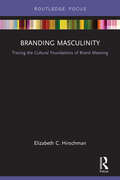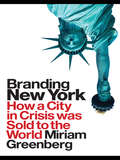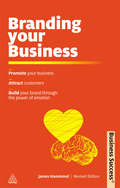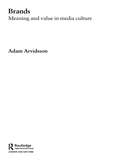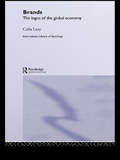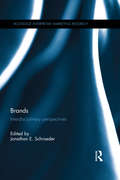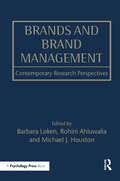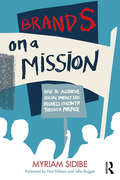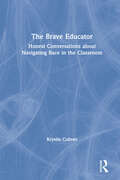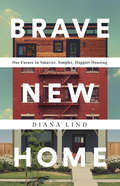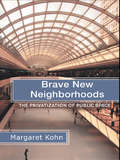- Table View
- List View
Branding Center: Über den Einfluss globaler Markenkonzerne auf die Innenstädte
by Frank RoostGlobal agierende Markenkonzerne errichten immer häufiger Showrooms, Flagship Stores und Firmenmuseen, die ihnen als dreidimensionale Werbung dienen. Vor allem in den Metropolen prägen solche als Branding Center bezeichneten Bauten zunehmend das Stadtbild. Am Beispiel von Projekten der Sony Corporation in Berlin, San Francisco und Tokyo untersucht der Autor, wie die globalen Marketingstrategien der Konzerne und die lokalen planerischen Konzepte bei dieser neuen Form der Stadtproduktion zusammenwirken. Dabei stellt er den Zusammenhang mit dem globalisierungsbedingten Wandel der Produktions- und Konsummuster dar, bestimmt den Stellenwert der imageorientierten Investitionen für die Stadtentwicklung und zeigt die Handlungsspielräume im planerischen Umgang mit den Branding Centern.
Branding Masculinity: Tracing the Cultural Foundations of Brand Meaning (Routledge Interpretive Marketing Research)
by Elizabeth C. HirschmanBranding Masculinity examines two ideologies of masculinity – one typifying rural agricultural areas and the other found in urban, business settings. Comparisons are made between these two current forms of masculinity and both similarities and differences are identified. Six product categories compose the Constellation of Masculinity for both groups. Hirschman selects a masculine prototype brand from each category and presents a detailed analysis of the images, language and marketing actions used to create the brand's masculinity over time. Using her method, marketers for other brands will be equipped to enhance the masculine status of their brands, as well. Branding Masculinity proposes that masculine brands are made, not born. Masculinity is an enduring cultural ideal which can be attached to a variety of products and brands by the appropriate use of symbols, icons and images. Scholars from various disciplines within the fields of branding, marketing, public relations and corporate identity will see this book as vital in continuing the academic discourse in the field. It will serve as a respected reference resource for researchers, academics, students and policy makers, alike.
Branding Masculinity: Tracing the Cultural Foundations of Brand Meaning (Routledge Interpretive Marketing Research)
by Elizabeth C. HirschmanBranding Masculinity examines two ideologies of masculinity – one typifying rural agricultural areas and the other found in urban, business settings. Comparisons are made between these two current forms of masculinity and both similarities and differences are identified. Six product categories compose the Constellation of Masculinity for both groups. Hirschman selects a masculine prototype brand from each category and presents a detailed analysis of the images, language and marketing actions used to create the brand's masculinity over time. Using her method, marketers for other brands will be equipped to enhance the masculine status of their brands, as well. Branding Masculinity proposes that masculine brands are made, not born. Masculinity is an enduring cultural ideal which can be attached to a variety of products and brands by the appropriate use of symbols, icons and images. Scholars from various disciplines within the fields of branding, marketing, public relations and corporate identity will see this book as vital in continuing the academic discourse in the field. It will serve as a respected reference resource for researchers, academics, students and policy makers, alike.
Branding New York: How a City in Crisis Was Sold to the World
by Miriam GreenbergWinner of the 2009 Robert Park Book Award for best Community and Urban Sociology book! Branding New York traces the rise of New York City as a brand and the resultant transformation of urban politics and public life. Greenberg addresses the role of "image" in urban history, showing who produces brands and how, and demonstrates the enormous consequences of branding. She shows that the branding of New York was not simply a marketing tool; rather it was a political strategy meant to legitimatize market-based solutions over social objectives.
Branding New York: How a City in Crisis Was Sold to the World
by Miriam GreenbergWinner of the 2009 Robert Park Book Award for best Community and Urban Sociology book! Branding New York traces the rise of New York City as a brand and the resultant transformation of urban politics and public life. Greenberg addresses the role of "image" in urban history, showing who produces brands and how, and demonstrates the enormous consequences of branding. She shows that the branding of New York was not simply a marketing tool; rather it was a political strategy meant to legitimatize market-based solutions over social objectives.
Branding Your Business: Promote Your Business, Attract Customers and Build Your Brand Through the Power of Emotion (Business Success)
by James HammondThe only way forward for business success is to create a memorable brand and fix it in the consumer's mind. Branding Your Business explains the whole branding process in easy-to-follow terms. Providing practical help instead of academic theories, it explains what a brand is and what it is not, how to conduct a 'DIY' brand audit and how to use marketing NLP and psychology principles to create a powerful brand for your business.Based around the theory that a brand is the total perception a customer has about a company, its products or services, Branding Your Business will reveal what is needed to create and manage successful brands, increase profits and leave the competition standing.
Branding Your Business: Promote Your Business, Attract Customers and Build Your Brand Through the Power of Emotion (Business Success)
by James HammondThe only way forward for business success is to create a memorable brand and fix it in the consumer's mind. Branding Your Business explains the whole branding process in easy-to-follow terms. Providing practical help instead of academic theories, it explains what a brand is and what it is not, how to conduct a 'DIY' brand audit and how to use marketing NLP and psychology principles to create a powerful brand for your business.Based around the theory that a brand is the total perception a customer has about a company, its products or services, Branding Your Business will reveal what is needed to create and manage successful brands, increase profits and leave the competition standing.
Brands: Meaning and Value in Media Culture
by Adam ArvidssonDrawing on rich empirical material, this revealing book builds up a critical theory, arguing that brands have become an important tool for transforming everyday life into economic value. When branding lifestyles or value complexes onto their products, companies assume that consumers desire products for their ability to give meaning to their lives. Yet, brands also have a key function within managerial strategy. Examining the history of audience and market research, marketing thought and advertising strategy; the first part of this book traces the historical development of branding, whilst the second part evaluates new media, contemporary management and overall media economics to present the first systematic theory of brands: the brand as a key institution in information capitalism. It includes chapters on: consumption marketing brand management online branding the brand as informational capital. Richly illustrated with case studies from market research, advertising, shop displays, mobile phones, the internet and virtual companies, this outstanding book is essential reading for students and researchers of the sociology of media, cultural studies, advertising and consumer studies and marketing.
Brands: Meaning and Value in Media Culture
by Adam ArvidssonDrawing on rich empirical material, this revealing book builds up a critical theory, arguing that brands have become an important tool for transforming everyday life into economic value. When branding lifestyles or value complexes onto their products, companies assume that consumers desire products for their ability to give meaning to their lives. Yet, brands also have a key function within managerial strategy. Examining the history of audience and market research, marketing thought and advertising strategy; the first part of this book traces the historical development of branding, whilst the second part evaluates new media, contemporary management and overall media economics to present the first systematic theory of brands: the brand as a key institution in information capitalism. It includes chapters on: consumption marketing brand management online branding the brand as informational capital. Richly illustrated with case studies from market research, advertising, shop displays, mobile phones, the internet and virtual companies, this outstanding book is essential reading for students and researchers of the sociology of media, cultural studies, advertising and consumer studies and marketing.
Brands: The Logos of the Global Economy (International Library of Sociology)
by Celia LuryBrands are everywhere: in the air, on the high-street, in the kitchen, on television and, maybe even on your feet. But what are they? The brand, that point of connection between company and consumer, has become one of the key cultural forces of our time and one of the most important vehicles of globalization. This book offers a detailed and innovative analysis of the brandIllustrated with many examples, the book argues that brands:* mediate the supply and demand of products and services in a global economy* frame the activities of the market by functioning as an interface* communicate interactively, selectively promoting and inhibiting communication between producers and consumers* operate as a public currency while being legally protected as private property in law* introduce sensation, qualities and affect into the quantitative calculations of the market* organize the logics of global flows of products, people, images and events.This book will be essential reading for students of sociology, cultural studies and consumption.
Brands: The Logos of the Global Economy (International Library of Sociology)
by Celia LuryBrands are everywhere: in the air, on the high-street, in the kitchen, on television and, maybe even on your feet. But what are they? The brand, that point of connection between company and consumer, has become one of the key cultural forces of our time and one of the most important vehicles of globalization. This book offers a detailed and innovative analysis of the brandIllustrated with many examples, the book argues that brands:* mediate the supply and demand of products and services in a global economy* frame the activities of the market by functioning as an interface* communicate interactively, selectively promoting and inhibiting communication between producers and consumers* operate as a public currency while being legally protected as private property in law* introduce sensation, qualities and affect into the quantitative calculations of the market* organize the logics of global flows of products, people, images and events.This book will be essential reading for students of sociology, cultural studies and consumption.
Brands: Interdisciplinary Perspectives (Routledge Interpretive Marketing Research)
by Jonathan E. SchroederBranding has emerged as a cornerstone of marketing practice and corporate strategy, as well as a central cultural practice. In this book, Jonathan Schroeder brings together a curated selection of the most influential and thought-provoking papers on brands and branding from Consumption Markets and Culture, accompanied by new contributions from leading brand scholars Giana Eckhardt, John F. Sherry, Jr., Sidney Levy and Morris Holbrook. Organised into four perspectives – cultural, corporate, consumer, critical - these papers are chosen to highlight the complexities of contemporary branding through leading consumer brands such as Disney, eBay, Guinness, McDonalds, Nike, and Starbucks. They address key topics such as celebrity branding, corporate branding, place branding, and retail branding and critique the complexities of contemporary brands to provide a rich trove of interdisciplinary research insights into the function of brands as ethical, ideological and political objects. This thought-provoking collection will be of interest to all scholars of marketing, consumer behaviour, anthropology and sociology, and anyone interested in the powerful roles brands play in consumer’s lives and cultural discourse.
Brands: Interdisciplinary Perspectives (Routledge Interpretive Marketing Research)
by Jonathan E. SchroederBranding has emerged as a cornerstone of marketing practice and corporate strategy, as well as a central cultural practice. In this book, Jonathan Schroeder brings together a curated selection of the most influential and thought-provoking papers on brands and branding from Consumption Markets and Culture, accompanied by new contributions from leading brand scholars Giana Eckhardt, John F. Sherry, Jr., Sidney Levy and Morris Holbrook. Organised into four perspectives – cultural, corporate, consumer, critical - these papers are chosen to highlight the complexities of contemporary branding through leading consumer brands such as Disney, eBay, Guinness, McDonalds, Nike, and Starbucks. They address key topics such as celebrity branding, corporate branding, place branding, and retail branding and critique the complexities of contemporary brands to provide a rich trove of interdisciplinary research insights into the function of brands as ethical, ideological and political objects. This thought-provoking collection will be of interest to all scholars of marketing, consumer behaviour, anthropology and sociology, and anyone interested in the powerful roles brands play in consumer’s lives and cultural discourse.
Brands and Brand Management: Contemporary Research Perspectives (Marketing And Consumer Psychology Ser.)
by Barbara Loken Rohini Ahluwalia Michael J. HoustonVery few books exist that meaningfully integrate the rich and vast body of scientific research and theories that have accumulated in the field, relating to both traditional and contemporary topics in branding. This book accomplishes that task, with contributions from leading experts in the science of branding, national and international. The book should appeal to all students, faculty, and marketing professionals with an interest in research findings about brands, and an interest in deepening their understanding of how consumers view brands.
Brands and Brand Management: Contemporary Research Perspectives
Very few books exist that meaningfully integrate the rich and vast body of scientific research and theories that have accumulated in the field, relating to both traditional and contemporary topics in branding. This book accomplishes that task, with contributions from leading experts in the science of branding, national and international. The book should appeal to all students, faculty, and marketing professionals with an interest in research findings about brands, and an interest in deepening their understanding of how consumers view brands.
Brands and the City: Entanglements and Implications for Urban Life (Cities and Society)
by Sonia BookmanFrom commercial retail environments to branded urban villages, brands are now a salient feature of contemporary cityscapes and are deeply entwined in people’s everyday lives. Drawing on extensive empirical material and recent theoretical developments in the sociology of brands, this book explores the complex relationship between brands, consumption and urban life. Covering a range of brands and branding in the city, from themed retail stores to branded cultural quarters, it considers how brands provide new ways of mediating identities, lifestyles and social relations. At the same time, the book reveals how brands are bound up with forms of socio-spatial division and exclusion in the city, defining what kinds of practices, images or attitudes are acceptable in a particular place, constituting cultural boundaries that keep certain people and activities out. With attention throughout to the social and cultural implications of the presence of brands in urban space, Brands and the City examines how people engage with brands, and how brands shape urbanites’ experiences and sense of self, society and space. An extensive exploration of the processes through which brands are integrated into cities, their effects on everyday experiences and their role in the policing and governance of urban space, this book will appeal to scholars across the social sciences with interests in urban studies, consumption and branding.
Brands and the City: Entanglements and Implications for Urban Life (Cities and Society)
by Sonia BookmanFrom commercial retail environments to branded urban villages, brands are now a salient feature of contemporary cityscapes and are deeply entwined in people’s everyday lives. Drawing on extensive empirical material and recent theoretical developments in the sociology of brands, this book explores the complex relationship between brands, consumption and urban life. Covering a range of brands and branding in the city, from themed retail stores to branded cultural quarters, it considers how brands provide new ways of mediating identities, lifestyles and social relations. At the same time, the book reveals how brands are bound up with forms of socio-spatial division and exclusion in the city, defining what kinds of practices, images or attitudes are acceptable in a particular place, constituting cultural boundaries that keep certain people and activities out. With attention throughout to the social and cultural implications of the presence of brands in urban space, Brands and the City examines how people engage with brands, and how brands shape urbanites’ experiences and sense of self, society and space. An extensive exploration of the processes through which brands are integrated into cities, their effects on everyday experiences and their role in the policing and governance of urban space, this book will appeal to scholars across the social sciences with interests in urban studies, consumption and branding.
Brands on a Mission: How to Achieve Social Impact and Business Growth Through Purpose
by Myriam SidibeBrands on a Mission explores the importance of creating a performance culture that is built on driving impact through purpose, and the type of talent required to drive these transformational changes within companies – from CEO to brand developers. Using evidence from interviews and stories from over 100 CEOs, thought leaders and brand managers, the book presents an emergent model that organisations can follow to build purpose into their growth strategy – and shows how to bridge the gap between Brand Say and Brand Do. Readers will learn from the real experts in the field: how Paul Polman, former CEO of Unilever, built purpose into the DNA of his company; what keeps Alan Jope (new CEO, Unilever) and Emmanuel Faber (CEO, Danone) awake at night; and how brand developers from Durex, Dove, Discovery and LIXIL have made choices and the reasons behind them. In this book you will learn how a soap brand Lifebuoy taught one billion people about hygiene, how a beer is tackling gender-based violence, and how a toothpaste is tackling school absenteeism amongst many others. Renowned experts like Peter Piot (Director, London School of Health and Tropical Medicine), Michael Porter (Professor, Harvard School of Business), Jane Nelson (Director, Corporate Responsibility Initiative, Harvard Kennedy School) and Susie Orbach (leading feminist and formerly professor, London School of Economics) also share examples, data and their everyday experiences of helping corporates create a culture of purpose. And leading NGOs and UN experts like Lawrence Haddad (Executive Director, GAIN) and Natalia Kanem (Executive Director of UNFPA) will recount how the public and private sector have worked together to create an accelerated path to reaching the Sustainable Development Goals by 2030. The book provides a clear pathway of how to take brands through the journey of developing impactful social missions and driving business growth, and is an essential guide for both managers and students alike.
Brands on a Mission: How to Achieve Social Impact and Business Growth Through Purpose
by Myriam SidibeBrands on a Mission explores the importance of creating a performance culture that is built on driving impact through purpose, and the type of talent required to drive these transformational changes within companies – from CEO to brand developers. Using evidence from interviews and stories from over 100 CEOs, thought leaders and brand managers, the book presents an emergent model that organisations can follow to build purpose into their growth strategy – and shows how to bridge the gap between Brand Say and Brand Do. Readers will learn from the real experts in the field: how Paul Polman, former CEO of Unilever, built purpose into the DNA of his company; what keeps Alan Jope (new CEO, Unilever) and Emmanuel Faber (CEO, Danone) awake at night; and how brand developers from Durex, Dove, Discovery and LIXIL have made choices and the reasons behind them. In this book you will learn how a soap brand Lifebuoy taught one billion people about hygiene, how a beer is tackling gender-based violence, and how a toothpaste is tackling school absenteeism amongst many others. Renowned experts like Peter Piot (Director, London School of Health and Tropical Medicine), Michael Porter (Professor, Harvard School of Business), Jane Nelson (Director, Corporate Responsibility Initiative, Harvard Kennedy School) and Susie Orbach (leading feminist and formerly professor, London School of Economics) also share examples, data and their everyday experiences of helping corporates create a culture of purpose. And leading NGOs and UN experts like Lawrence Haddad (Executive Director, GAIN) and Natalia Kanem (Executive Director of UNFPA) will recount how the public and private sector have worked together to create an accelerated path to reaching the Sustainable Development Goals by 2030. The book provides a clear pathway of how to take brands through the journey of developing impactful social missions and driving business growth, and is an essential guide for both managers and students alike.
Brasilien zwischen Multikulturalismus und Transkulturalität: Mestiçagem als transkultureller Sonderweg
by Susanne KrügerDas Buch hinterfragt, inwiefern sich die ethnisch durchmischte Zusammensetzung der brasilianischen Gesellschaft in den aus der Theorie bekannten Dualismus von Multikulturalismus und Transkulturalität einordnen lässt. Der brasilianische Begriff der mestiçagem – übersetzt mit Rassenmischung – wird also in diesem zeitgenössischen Kontext kulturbezogener Forschung neu vermessen. Die Autorin reflektiert ideengeschichtlich multi- und transkulturelle Ansätze und zeigt auf, dass diese oftmals von einer westlich zentrierten Voreingenommenheit eingeengt sind. Der Blick auf die brasilianische Identitätskonstruktion wird als Anstoß genommen, über alternative Perspektiven nachzudenken.
The Brave Educator: Honest Conversations about Navigating Race in the Classroom
by Krystle CobranThe Brave Educator equips you with accessible and refreshingly useful tools for real conversations about race that prepare students for the world beyond the school walls. More than a toolkit, this book is a personal conversation exploring the journey from being stuck in the belief that we should already know how to lead conversations about race to learning how to actually have the conversation. It’s companionship for educators, leaders, and teachers facing overwhelming daily responsibilities and searching for open-hearted support. Inside you’ll find a flexible road map to help carve a path through difficult conversations in your classroom, plus question prompts, resource lists, and crucial tips to help you avoid common pitfalls. The grounded perspective and real-world examples in these pages will help you feel less alone as you move from tentative to prepared.
The Brave Educator: Honest Conversations about Navigating Race in the Classroom
by Krystle CobranThe Brave Educator equips you with accessible and refreshingly useful tools for real conversations about race that prepare students for the world beyond the school walls. More than a toolkit, this book is a personal conversation exploring the journey from being stuck in the belief that we should already know how to lead conversations about race to learning how to actually have the conversation. It’s companionship for educators, leaders, and teachers facing overwhelming daily responsibilities and searching for open-hearted support. Inside you’ll find a flexible road map to help carve a path through difficult conversations in your classroom, plus question prompts, resource lists, and crucial tips to help you avoid common pitfalls. The grounded perspective and real-world examples in these pages will help you feel less alone as you move from tentative to prepared.
Brave New Home: Our Future in Smarter, Simpler, Happier Housing
by Diana LindA smart, provocative look at how the American Dream of single-family homes, white picket fences and two-car garages became a lonely, overpriced nightmare, and how new trends in housing can help us live better. Over the past century, American demographics and social norms have shifted dramatically. More people are living alone, marrying later in life, and having smaller families. At the same time, their lifestyles are changing, whether by choice or by force, to become more virtual, more mobile, and less stable. But despite the ways that today's America is different and more diverse, housing still looks stuck in the 1950s. In Brave New Home, Diana Lind shows why a country full of single-family houses is bad for us and our planet, and details the new efforts underway that better reflect the way we live now, to ensure that the way we live next is both less lonely and more affordable. Lind takes readers into the homes and communities that are seeking alternatives to the American norm, from multi-generational living, in-law suites, and co-living to microapartments, tiny houses, and new rural communities.Drawing on Lind's expertise and the stories of Americans caught in or forging their own paths outside of our cookie-cutter housing trap, Brave New Home offers a diagnosis of the current crisis in American housing and a radical re-imagining of the possibilities of housing.
Brave New Neighborhoods: The Privatization of Public Space
by Margaret KohnFighting for First Amendment rights is as popular a pastime as ever, but just because you can get on your soapbox doesn't mean anyone will be there to listen. Town squares have emptied out as shoppers decamp for the megamalls; gated communities keep pesky signature gathering activists away; even most internet chatrooms are run by the major media companies. Brave New Neighborhood sconsiders what can be done to protect and revitalize our public spaces.
Brave New Neighborhoods: The Privatization of Public Space
by Margaret KohnFighting for First Amendment rights is as popular a pastime as ever, but just because you can get on your soapbox doesn't mean anyone will be there to listen. Town squares have emptied out as shoppers decamp for the megamalls; gated communities keep pesky signature gathering activists away; even most internet chatrooms are run by the major media companies. Brave New Neighborhood sconsiders what can be done to protect and revitalize our public spaces.

